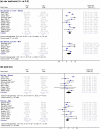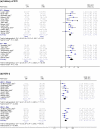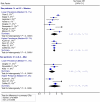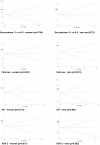Sexual risk factors for HIV infection in early and advanced HIV epidemics in sub-Saharan Africa: systematic overview of 68 epidemiological studies
- PMID: 17912340
- PMCID: PMC1994584
- DOI: 10.1371/journal.pone.0001001
Sexual risk factors for HIV infection in early and advanced HIV epidemics in sub-Saharan Africa: systematic overview of 68 epidemiological studies
Abstract
Background: It is commonly assumed that sexual risk factors for heterosexual HIV transmission in sub-Saharan Africa, such as multi-partner sex, paid sex and co-infections, become less important as HIV epidemics mature and prevalence increases.
Methods and findings: We conducted a systematic review of 68 African epidemiological studies from 1986 to 2006 involving 17,000 HIV positive adults and 73,000 controls. We used random-effects methods and stratified results by gender, time, background HIV prevalence rates and other variables. The number of sex partners, history of paid sex, and infection with herpes simplex virus (HSV-2) or other sexually-transmitted infections (STIs) each showed significant associations with HIV infection. Among the general population, the odds ratio (OR) of HIV infection for women reporting 3+ sex partners versus 0-2 was 3.64 (95%CI [2.87-4.62]), with similar risks for men. About 9% of infected women reported ever having been paid for sex, versus 4% of control women (OR = 2.29, [1.45-3.62]). About 31% of infected men reported ever paying for sex versus 18% of uninfected men (OR = 1.75, [1.30-2.36]). HSV-2 infection carried the largest risk of HIV infection: OR = 4.62, [2.85-7.47] in women, and OR = 6.97, [4.68-10.38] in men. These risks changed little over time and stratification by lower and higher HIV background prevalence showed that risk ratios for most variables were larger in high prevalence settings. Among uninfected controls, the male-female differences in the number of sex partners and in paid sex were more extreme in the higher HIV prevalence settings than in the lower prevalence settings.
Significance: Multi-partner sex, paid sex, STIs and HSV-2 infection are as important to HIV transmission in advanced as in early HIV epidemics. Even in high prevalence settings, prevention among people with high rates of partner change, such as female sex workers and their male clients, is likely to reduce transmission overall.
Conflict of interest statement
Figures








References
-
- UNAIDS. Geneva: WHO/UNAIDS; 2006. AIDS Epidemic Update.
-
- Cote AM, Sobela F, Dzokoto A, Nzambi K, Samoah-Adu C, et al. Transactional sex is the driving force in the dynamics of HIV in Accra, Ghana. AIDS. 2004;18:917–25. - PubMed
-
- Cohen MS, Hoffman IF, Royce RA, Kazembe P, Dyer JR, et al. Reduction of concentration of HIV-1 in semen after treatment of urethritis: implications for prevention of sexual transmission of HIV-1. AIDSCAP Malawi Research Group. Lancet. 1997;349:1868–73. - PubMed
-
- Freeman EE, Weiss HA, Glynn JR, Cross PL, Whitworth JA, et al. Herpes simplex virus 2 infection increases HIV acquisition in men and women: systematic review and meta-analysis of longitudinal studies. AIDS. 2006;20:73–83. - PubMed
-
- Weiss HA, Quigley MA, Hayes RJ. Male circumcision and risk of HIV infection in sub-Saharan Africa: a systematic review and meta-analysis. AIDS. 2000;14:2361–70. - PubMed
Publication types
MeSH terms
LinkOut - more resources
Full Text Sources
Medical

